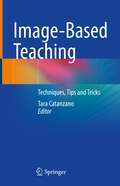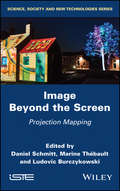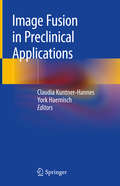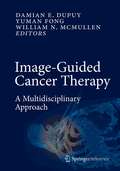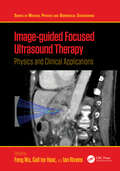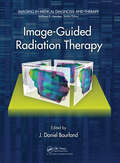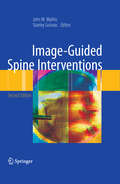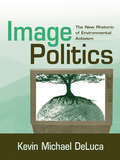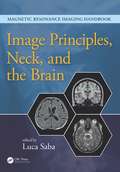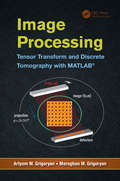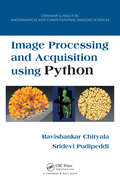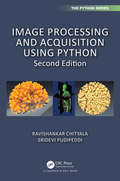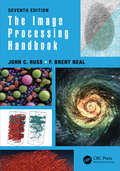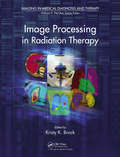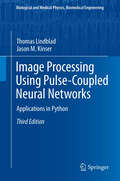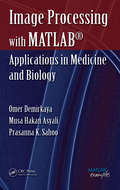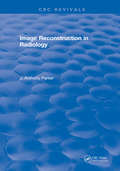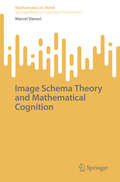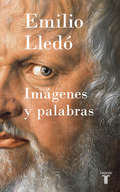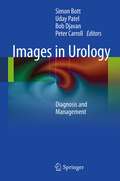- Table View
- List View
Image-Based Multilevel Biomechanical Modeling for Fall-Induced Hip Fracture
by Yunhua LuoFall-induced hip fracture is an epidemic health risk among elderly people. This book presents an image-based multilevel modeling approach to understanding the biomechanics involved in fall-induced hip fracture. By hierarchically integrating a body-level dynamics model, a femur-level finite element model, and a local bone failure model, the biomechanics approach is able to simulate all stages in sideways falls and to incorporate all biomechanical variables affecting hip fracture. This book is useful for clinicians to accurately evaluate fracture risk, for biomechanical engineers to virtually test hip protective devices, and for biomedical students to learn image-based biomechanical modeling techniques. This book also covers: Biomechanical viewing on bone composition, bone remodeling, and bone strength Bone imaging and information captured for constructing biomechanical models Bone mechanical testing and mechanical properties required for biomechanical modeling
Image-Based Teaching: Techniques, Tips and Tricks
by Tara CatanzanoThis book offers detailed information on a variety of teaching techniques for radiology. Generational differences in communication and adult learning theory have led to changes in educational content delivery. Traditional didactic teaching methods are no longer embraced by students, requiring educators to learn and adopt new techniques. Radiologists currently in practice have little or no experience with these newer techniques, some thrust upon them abruptly by the COVID pandemic. In addition to practicing radiologists, the next generation of educators are currently in training and often do not receive instruction on educational theory and teaching techniques. It is incumbent upon members of the educational sphere to provide resources for these individuals. This work intends to provide just such a resource.The objectives of the book include: Explaining adult learning theory and brain-friendly teachingDescribing teaching techniques to leverage brain-friendly teachingReinforcing key points with links to online video-based lectures as an accompaniment to the text Topics covered across chapters include helping non-teaching faculty to teach, writing high quality MCQ questions, and teaching quality, safety, and professionalism. Each chapter will have one “key takeaway” chart at the conclusion of the chapter with high-yield key points highlighted in a bulleted format.This is an ideal guide for practicing radiologists, including those not currently working in academic centers. Faculty in non-academic centers can specifically benefit from chapters related to medical student, clinician and patient education. Future academic radiologists (i.e., fellows and residents) can benefit from the text as a foundation for careers in teaching hospitals and academic medical centers.
Image Beyond the Screen: Projection Mapping
by Daniel Schmitt Marine Thébault Ludovic BurczykowskiVideomapping with its use of digital images is an audiovisual format that has gained traction with the creative industries. It consists of projecting images onto diverse surfaces, according to their geometric characteristics. It is also synonymous with spatial augmented reality, projection mapping and spatial correspondence. Image Beyond the Screen lays the foundations for a field of interdisciplinary study, encompassing the audiovisual, humanities, and digital creation and technologies. It brings together contributions from researchers, and testimonials from some of the creators, technicians and organizers who now make up the many-faceted community of videomapping. Live entertainment, museum, urban or event planning, cultural heritage, marketing, industry and the medical field are just a few examples of the applications of this media.
Image Fusion in Preclinical Applications
by Claudia Kuntner-Hannes York HaemischThis book provides an accessible and comprehensive overview of the state of the art in multimodal, multiparametric preclinical imaging, covering all the modalities used in preclinical research. The role of different combinations of PET, CT, MR, optical, and optoacoustic imaging methods is examined and explained for a range of applications, from research in oncology, neurology, and cardiology to drug development. Examples of animal studies are highlighted in which multimodal imaging has been pivotal in delivering otherwise unobtainable information. Hardware and software image registration methods and animal-specific factors are also discussed. The readily understandable text is enhanced by numerous informative illustrations that help the reader to appreciate the similarities to, but also the differences from, clinical applications. Image Fusion in Preclinical Applications will be of interest to all who wish to learn more about the use of multimodal/multiparametric imaging as a tool for in vivo investigations in preclinical medical and pharmaceutical research.
Image-Guided Aesthetic Treatments
by Robert BardThis book offers a detailed and up-to-date overview of image-guided aesthetic treatments. A wide range of aesthetic image-guided procedures in different body regions are described in more than twenty chapters. For each procedure, the benefits of image guidance are identified and its use is clearly explained. The coverage includes all the major tools commonly employed by today’s aesthetic and plastic surgeons, such as spectral imaging, laser, microfocused ultrasound, and radiofrequency technologies. Image guidance of aesthetic treatments has a variety of benefits: Image-guided treatment by means of non-surgical or minimally invasive modalities greatly reduces patient anxiety and the likelihood of postoperative disfigurement. Image guidance allows the physician to measure the skin thickness and the depth of fat tissue and to evaluate the elasticity of the skin and subcutaneous tissues, improving thermal treatment outcomes. It can also map the arteries, veins, and nerves, thereby providing preoperative landmarks and permitting reduction of postoperative bleeding and avoidance of nerve damage. Furthermore, imaging can non-invasively identify subdermal fillers or implants, assisting in the identification of migration with attendant vascular compromise or nerve entrapment. Image-Guided Aesthetic Treatments will be a valuable guide and reference not only for aesthetic practitioners, plastic surgeons, and other specialists, but also for imaging technicians and interested laypersons.
Image-Guided Cancer Therapy: A Multidisciplinary Approach
by Damian E. Dupuy William N. Mcmullen Yuman FongImage-Guided Cancer Therapy: A Multidisciplinary Approach provides clinicians with in-depth coverage of the growing, dynamic field of interventional oncology. Combining the knowledge of expert editors and authors into one powerhouse reference, this book looks at tumor ablation, HIFU, embolic therapies, emerging technologies, and radiation therapy throughout the body (liver, bone, breast, gynecologic and prostate cancers, to name just a few) , and includes discussion of different imaging modalities. In the words of Peter Mueller, MD, author of the book's Foreword: "... The senior authors are all world renowned experts in interventional oncology, which is another example of the high quality authorship and experience that is brought to this book. The later chapters discuss therapies that are simply not covered in any other source. Everyone who is doing or wants to do ablation therapies and interventional oncology will face a time when they will be asked to use their expertise in less used and less investigated areas. There is nowhere else where the reader can get information on the prostate, breast, and gynecologic areas, and especially pediatrics....This book is an outstanding contribution to the literature and will become a 'must read' for all physicians who are interested in Interventional Oncology."
Image-guided Focused Ultrasound Therapy: Physics and Clinical Applications (ISSN)
by Feng Wu Gail Ter Haar Ian RivensUltrasound has been widely used in diagnostic imaging for a long time. In the past 10 years, image-guided focused ultrasound therapy has seen rapid growth, in biomedical science and engineering, and in clinical medicine. The purpose of this book is to bring internationally renowned authorities and experts in this field together to provide up-to-date and comprehensive reviews of basic physics, biomedical engineering, and clinical applications of focused ultrasound therapy in a widely accessible fashion.Focusing on applications in cancer treatment, this book covers basic principles, practical aspects, and clinical applications of focused ultrasound therapy. It reviews the medical physics and bio-effects of focused ultrasound beams on living tissues, dosimetric methods and measurements, transducer engineering, image guidance and monitoring (including magnetic resonance imaging -- MRI -- and ultrasound), treatment delivery systems, and clinical applications. The book also gives practical guidelines on patient setup, target localisation, treatment planning and image-guided procedures for the treatment in various sites, including the prostate, liver, pancreas, breast, kidney, uterus, bone, and brain.The book discusses major challenges for the use of focused ultrasound energy on living tissues and explores the cellular and physiological responses that can be employed in the fight against cancer from biological, physics and engineering perspectives. It also highlights recent advances, including the treatment of solid tumours using image-guided drug delivery, and the exploitation of microbubbles, nanoparticles, and other cutting-edge techniques. Readers who are interested in learning more about the technique and the clinical applications described in each chapter can find more information in the comprehensive bibliographies provided.This book is suitable for anyone involved in, or looking to become involved in, the research and clinical applications of focused ultrasound therapy, including medical professionals, physicists, biomedical engineers, graduate students and others working in this multidisciplinary field. It offers a balanced and critical assessment of state-of-the-art technologies, major challenges, and an outlook on the future of focused ultrasound therapy. It presents a thorough introduction for those new to the field while providing helpful, up-to-date information and guidelines for readers already using this therapy in clinical and pre-clinical settings.Key Features: Brings together a wide range of world-leading experts in this new field, presenting the latest clinical outcomes of using focused ultrasound for the treatment of benign and malignant diseases Covers the fundamental physics of focused ultrasound therapy and ultrasound-mediated drug delivery, including chapters on the mechanism of sonoporation, microbubble and ultrasound interaction, and their potential clinical applications Introduces clinical guidelines for focused ultrasound therapy, including indications and contraindications, treatment goals, the selection of patients, clinical observation during treatment procedure and follow-up, and characteristics of image changes after treatment
Image-Guided High-Precision Radiotherapy
by Esther G. C. TroostThis book equips readers with detailed knowledge on the current status of image-guided radiotherapy with photons and particles and highlights issues that need to be addressed in order to further improve treatment outcomes. The opening chapters cover clinical and technical aspects of target volume definition using anatomic (computed tomography and magnetic resonance imaging; MRI) as well as functional (MRI and positron emission tomography) imaging. Up-to-date information is then provided on the full range of image-guided high-precision radiotherapy techniques, including IMRT/VMAT, stereotactic body radiation therapy, MR-guided linear accelerators, MR-guided brachytherapy, and particle therapy. The role of ultrasonography in image-guided radiotherapy is discussed, as are the available means for target volume demarcation and stabilization and adaptive radiation therapy. Finally, outcome evaluation is explored in depth, with a particular focus on the role of multimodality imaging in predicting tumor control and normal tissue toxicity. The authors are experts in different specialties and the book will be of high value for radiation oncologists, medical physicists, radiologists, nuclear medicine physicians, and radiation technicians.
Image-Guided Management of COVID-19 Lung Disease
by Robert L. BardThis book offers a detailed and up-to-date overview of image-guided diagnostics in COVID-19 lung disease. A range of image-guided CT and ultrasound procedures in different chest regions are described. For each procedure, the benefits of image guidance are presented and its specialized application explained in the adult (outpatient, triage and hospital setting) and the pediatric patient. Lung Ultrasound Image Guidance assesses this rapidly evolving disease in real time while CT scans may be precisely targeted. The editor provides his 50+ year experience of multidisciplinary chest imaging including battlefield experience to optimally combat this recent viral assault. Image-Guided Management will be a valuable guide and reference not only for radiologists and pulmonary practitioners, but also for imaging technicians and First Responders. The intense public interest in safety and prevention is covered in the chapters on protection and decontamination. A chapter addressing the multiplicity of organ damage is useful for cardiologists and internists given the long differential diagnosis of respiratory distress entities. The emergence of point of care ultrasound providing 24/7 diagnostic access into inflammatory processes of the lung heralds its ascendance to the top tier of acute care diagnostic tools.
Image-Guided Radiation Therapy (Imaging in Medical Diagnosis and Therapy)
by J. Daniel BourlandImage-Guided Radiation Therapy presents key image-guided radiation treatment (IGRT) technologies for external beam radiotherapy. The book explores the decades-long technological developments that have occurred in the realm of image-guided conformal, customized radiation treatment. Expert authors, all of whom have actively participated in the develo
Image-Guided Spine Interventions
by Stanley Golovac John M. MathisHere is the second, completely revised and updated edition of the successful practical guide to image-guided spine intervention. It contains revised text and images as well as new sections and chapters. The updated text thoroughly discusses both well-established and new interventions that are applied to the spine for the purpose of pain relief.
Image Politics: The New Rhetoric of Environmental Activism (Revisioning Rhetoric Ser.)
by Kevin Michael DeLucaThis exceptional volume examines “image events” as a rhetorical tactic utilized by environmental activists. Author Kevin Michael DeLuca analyzes widely televised environmentalist actions in depth to illustrate how the image event fulfills fundamental rhetorical functions in constructing and transforming identities, discourses, communities, cultures, and world views. Image Politics also exhibits how such events create opportunities for a politics that does not rely on centralized leadership or universal metanarratives. The book presents a rhetoric of the visual for our mediated age as it illuminates new political possibilities currently enacted by radical environmental groups. Chapters in the volume cover key areas of environmental activism such as:*The rhetoric of social movements;*Imaging social movements;*Environmental justice groups; and*Participatory democracy. This book is of interest to scholars and students of rhetorical theory, media and communication theory, visual theory, environmental studies, social change movements, and political theory. It will also appeal to others interested in ecology, radical environmental politics, and activism, and is an excellent supplemental text in advanced undergraduate and graduate level courses in these areas.
Image Principles, Neck, and the Brain
by Luca SabaMagnetic resonance imaging (MRI) is a technique used in biomedical imaging and radiology to visualize internal structures of the body. Because MRI provides excellent contrast between different soft tissues, the technique is especially useful for diagnostic imaging of the brain, muscles, and heart.In the past 20 years, MRI technology has improved si
Image Processing: Tensor Transform and Discrete Tomography with MATLAB ®
by Artyom M. Grigoryan Merughan M. GrigoryanFocusing on mathematical methods in computer tomography, Image Processing: Tensor Transform and Discrete Tomography with MATLAB® introduces novel approaches to help in solving the problem of image reconstruction on the Cartesian lattice. Specifically, it discusses methods of image processing along parallel rays to more quickly and accurately reconstruct images from a finite number of projections, thereby avoiding overradiation of the body during a computed tomography (CT) scan. The book presents several new ideas, concepts, and methods, many of which have not been published elsewhere. New concepts include methods of transferring the geometry of rays from the plane to the Cartesian lattice, the point map of projections, the particle and its field function, and the statistical model of averaging. The authors supply numerous examples, MATLAB®-based programs, end-of-chapter problems, and experimental results of implementation. The main approach for image reconstruction proposed by the authors differs from existing methods of back-projection, iterative reconstruction, and Fourier and Radon filtering. In this book, the authors explain how to process each projection by a system of linear equations, or linear convolutions, to calculate the corresponding part of the 2-D tensor or paired transform of the discrete image. They then describe how to calculate the inverse transform to obtain the reconstruction. The proposed models for image reconstruction from projections are simple and result in more accurate reconstructions. Introducing a new theory and methods of image reconstruction, this book provides a solid grounding for those interested in further research and in obtaining new results. It encourages readers to develop effective applications of these methods in CT.
Image Processing and Acquisition using Python (Chapman And Hall/crc Mathematical And Computational Imaging Sciences Ser.)
by Ravishankar Chityala Sridevi PudipeddiImage Processing and Acquisition using Python provides readers with a sound foundation in both image acquisition and image processing-one of the first books to integrate these topics together. By improving readers' knowledge of image acquisition techniques and corresponding image processing, the book will help them perform experiments more effectiv
Image Processing and Acquisition using Python (Chapman & Hall/CRC The Python Series)
by Ravishankar Chityala Sridevi PudipeddiImage Processing and Acquisition using Python provides readers with a sound foundation in both image acquisition and image processing—one of the first books to integrate these topics together. By improving readers’ knowledge of image acquisition techniques and corresponding image processing, the book will help them perform experiments more effectively and cost efficiently as well as analyze and measure more accurately. Long recognized as one of the easiest languages for non-programmers to learn, Python is used in a variety of practical examples. A refresher for more experienced readers, the first part of the book presents an introduction to Python, Python modules, reading and writing images using Python, and an introduction to images. The second part discusses the basics of image processing, including pre/post processing using filters, segmentation, morphological operations, and measurements. The second part describes image acquisition using various modalities, such as x-ray, CT, MRI, light microscopy, and electron microscopy. These modalities encompass most of the common image acquisition methods currently used by researchers in academia and industry. Features Covers both the physical methods of obtaining images and the analytical processing methods required to understand the science behind the images. Contains many examples, detailed derivations, and working Python examples of the techniques. Offers practical tips on image acquisition and processing. Includes numerous exercises to test the reader’s skills in Python programming and image processing, with solutions to selected problems, example programs, and images available on the book’s web page. New to this edition Machine learning has become an indispensable part of image processing and computer vision, so in this new edition two new chapters are included: one on neural networks and the other on convolutional neural networks. A new chapter on affine transform and many new algorithms. Updated Python code aligned to the latest version of modules.
The Image Processing Handbook
by John C. Russ F. Brent NealConsistently rated as the best overall introduction to computer-based image processing, The Image Processing Handbook covers two-dimensional (2D) and three-dimensional (3D) imaging techniques, image printing and storage methods, image processing algorithms, image and feature measurement, quantitative image measurement analysis, and more.Incorporating image processing and analysis examples at all scales, from nano- to astro-, this Seventh Edition: Features a greater range of computationally intensive algorithms than previous versions Provides better organization, more quantitative results, and new material on recent developments Includes completely rewritten chapters on 3D imaging and a thoroughly revamped chapter on statistical analysis Contains more than 1700 references to theory, methods, and applications in a wide variety of disciplines Presents 500+ entirely new figures and images, with more than two-thirds appearing in color The Image Processing Handbook, Seventh Edition delivers an accessible and up-to-date treatment of image processing, offering broad coverage and comparison of algorithms, approaches, and outcomes.
Image Processing in Radiation Therapy (Imaging in Medical Diagnosis and Therapy)
by Kristy K. BrockImages from CT, MRI, PET, and other medical instrumentation have become central to the radiotherapy process in the past two decades, thus requiring medical physicists, clinicians, dosimetrists, radiation therapists, and trainees to integrate and segment these images efficiently and accurately in a clinical environment. Image Processing in Radiation
Image-Processing Techniques for Tumor Detection
by David F. Ross"Provides a current review of computer processing algorithms for the identification of lesions, abnormal masses, cancer, and disease in medical images. Presents useful examples from numerous imaging modalities for increased recognition of anomolies in MRI, CT, SPECT and digital/film X-Ray."
Image Processing using Pulse-Coupled Neural Networks: Applications in Python
by Thomas Lindblad Jason M. KinserImage processing algorithms based on the mammalian visual cortex are powerful tools for extraction information and manipulating images. This book reviews the neural theory and translates them into digital models. Applications are given in areas of image recognition, foveation, image fusion and information extraction. The third edition reflects renewed international interest in pulse image processing with updated sections presenting several newly developed applications. This edition also introduces a suite of Python scripts that assist readers in replicating results presented in the text and to further develop their own applications.
Image Processing with MATLAB: Applications in Medicine and Biology
by Omer Demirkaya Musa H. Asyali Prasanna K. SahooImage Processing with MATLAB: Applications in Medicine and Biology explains complex, theory-laden topics in image processing through examples and MATLAB algorithms. It describes classical as well emerging areas in image processing and analysis. Providing many unique MATLAB codes and functions throughout, the book covers the theory of probability an
Image Reconstruction in Radiology
by J. A. ParkerThis one-of-a-kind resource provides a very readable description of the methods used for image reconstruction in magnetic resonance imaging, X-ray computed tomography, and single photon emission computed tomography. The goal of this fascinating work is to provide radiologists with a practical introduction to mathematical methods so that they may better understand the potentials and limitations of the images used to make diagnoses. Presented in four parts, this state-of-the-art text covers (1) an introduction to the models used in reconstruction, (2) an explanation of the Fourier transform, (3) a brief description of filtering, and (4) the application of these methods to reconstruction. In order to provide a better understanding of the reconstruction process, this comprehensive volume draws analogies between several different reconstruction methods. This informative reference is an absolute must for all radiology residents, as well as graduate students and professionals in the fields of physics, nuclear medicine, and computer-assisted tomography.
Image Schema Theory and Mathematical Cognition (Mathematics in Mind)
by Marcel DanesiThis book uses blending theory in math cognition, and assesses the main aspect of this theory, called image schema theory. Applied work in math pedagogy has used this theory, but no work has assessed its validity. This book provides an overall assessment of the theory with regard to its validity in the study of math cognition. Overall, this book presents image schema theory as it has evolved today to mathematicians, cognitive scientists, and math educators, deriving from it any concrete implications for modeling math in computer science and, on the other side, for making math pedagogy more effective.
Imágenes y palabras
by Emilio LledóSencillo, profundo, uno de los libros clave de Emilio Lledó, gran exponente de la filosofía española contemporánea. «Este libro plantea, desde distintas perspectivas, algunas de las cuestiones relacionadas con una nueva visión de las llamadas "Humanidades". En realidad no hay forma alguna de conocimiento que no tenga que ver con los seres humanos y que no venga de ellos. Sorprende, pues, que se siga hablando de saber humanístico y saber científico como si no fueran hombres los que hacen también la Ciencia. Es hora ya de ir completando y extendiendo un concepto de humanismo que comprenda, en un bloque común de intereses, esas dos formas de cultura. »En estas páginas se apunta a un horizonte en el que sea posible superar esa injustificada y envejecida división. Los diferentes apartados que constituyen este libro tratan de arte, de filosofía, de literatura, de educación y, en ellos, aparecen algunas de las ideas sobre las que se ha levantado ese maravilloso mundo de la cultura, obra exclusiva de los seres humanos. Un mundo al que no podemos renunciar porque sería renunciar a la propia vida. El cuidado de ese universo ideal y real, y el esfuerzo por que se cultivo sea cada vez mejor y más libre es una de nuestras irrenunciables tareas. »La memoria de la cultura, el análisis renovado y aleccionador de los niveles y estímulos que encierra esa memoria, es una empresa apasionante y solidaria. Las páginas de este libro pretenden ser un pequeño paso en ese camino. Un camino nada utópico porque permite divisar "la realidad de la utopía": un territorio de posibilidad y libertad.»Emilio Lledó Esencial en la obra de Emilio Lledó, Imágenes y palabras es una hermosa recopilación de sus preocupaciones y obsesiones, en otras palabras, de lo que considera el centro del humanismo. Lenguaje, ética, arte, literatura, razón, libertad, felicidad, memoria... todos sus grandes temas están presentes, abordados desde perspectivas variadas y sin pretensiones de verdades absolutas. Un libro que es una excelente muestra del afán de claridad y de diálogo de este autor, y una maravillosa invitación a adoptar un sentido humanístico de la vida.
Images in Urology
by Peter R. Caroll Bob Djavan Simon Bott Uday PatelImages in Urology is a unique book that integrates images of urological conditions within their clinical context. Improvements in imaging techniques have meant greater diagnostic power and a dramatic rise in the number and quality of images obtained and viewed by practicing clinicians. None more so than in the field of urology, where static and dynamic images are fundamental to the diagnosis and treatment of almost all conditions. This book presents images of radiological and radionucleotide scans, macroscopic and microscopic histopathology specimens, urodynamic traces and photographs of dermatological conditions relating to urology. Each section has a series of questions, often relating to a clinical scenario, about the images. A comprehensive answer provides a description of each image and of the condition shown. Details of how to interpret the image and the use of contrast or staining methods to help differentiate normal anatomy from pathology are included. Images in Urology is an essential tool for urology, radiology and histopathology trainees and consultants, as well as being an excellent exam preparation guide.

